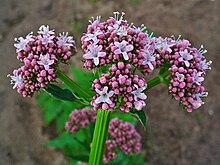Valeriana
| Valeriana | |
|---|---|

| |
| Garden valerian, Valeriana officinalis | |
| Scientific classification | |
| Kingdom: | Plantae |
| Clade: | Tracheophytes |
| Clade: | Angiosperms |
| Clade: | Eudicots |
| Clade: | Asterids |
| Order: | Dipsacales |
| Family: | Caprifoliaceae |
| Subfamily: | Valerianoideae |
| Genus: | Valeriana L., 1753 |
| Synonyms[1] | |
|
List
| |
Valeriana is a genus of flowering plants in the family Caprifoliaceae,[1] members of which may be commonly known as valerians. It contains many species, including the garden valerian, Valeriana officinalis. Valeriana has centers of diversity in Eurasia and South America (especially in the Andes), and is represented by native species on all continents except Antarctica.
Some species have been introduced to parts of the world outside their native range, including Valeriana rubra in the western United States[2] and Valeriana macrosiphon in Western Australia.[3]
Taxonomy
[edit]The genus was named by Carl Linnaeus after the Roman emperor Publius Licinius Valerianus who was said to use the plant as medicine.[4]: 16 The emperor's personal name comes from Valeria and the Latin verb valeo which means "to be strong".[5][6]
32 previously recognized genera, including Centranthus, Fedia, and Plectritis, are now considered synonyms of Valeriana.[1] Species in the former genus Centranthus are unusual in having flowers with "handedness", that is, having neither radial nor bilateral symmetry.[7]
Botany
[edit]Species from this genus are herbaceous and have woody roots. They grow vines with fine hairs and trifoliolate, pinnate leaves with serrated edges. They release a strong smell when they dry. Their flowers bloom from cymes.[8]
Fossil record
[edit]Fossil seeds of Valeriana sp, among them †Valeriana pliocenica, have been recovered from Late Miocene deposits of southern Ukraine, and from Pliocene deposits of south-eastern Belarus and Bashkortostan in central Russia. The fossil seeds are most similar to the extant European Valeriana simplicifolia (a subspecies of Valeriana dioica).[9]
Species
[edit]As of July 2024[update], Plants of the World Online accepts over 435 species and hybrids, including:[1]
- Valeriana alypifolia Kunth
- Valeriana amazonum (Fridl. & A.Raynal) Christenh. & Byng
- Valeriana aretioides Kunth
- Valeriana asterothrix Killip
- Valeriana bertiscea Pančić
- Valeriana buxifolia F.G.Mey.
- Valeriana calcitrapae L.
- Valeriana californica A.Heller
- Valeriana celtica L. – Alpine valerian or valerian spikenard
- Valeriana cernua B.Eriksen
- Valeriana ciliosa (Greene) Byng & Christenh. (2018) – longspur seablush
- Valeriana coleophylla Diels
- Valeriana dioica L. – marsh valerian
- Valeriana edulis Nutt.
- Valeriana eriocarpa (Desv.) Christenh. & Byng – Italian corn salad
- Valeriana fauriei Briq. – Korean valerian[10]
- Valeriana locusta L. – corn salad, lamb's lettuce, mâche, fetticus
- Valeriana macrocera (Torr. & A.Gray) Byng & Christenh. – longhorn seablush
- Valeriana macrosiphon (Boiss.) E.Vilm. – long-spurred valerian
- Valeriana montana L.
- Valeriana occidentalis A.Heller
- Valeriana officinalis L. – garden valerian
- Valeriana pauciflora Michx.
- Valeriana pyrenaica L. – Pyrenean valerian
- Valeriana rubra L. – red valerian
- Valeriana secunda B.Eriksen
- Valeriana sitchensis Bong. – Sitka valerian
- Valeriana trinervis Viv.
- Valeriana uliginosa (Torr. & A.Gray) Rydb.
- Valeriana umbilicata (Sull.) Christenh. & Byng – navel corn salad
- Valeriana woodsiana (Torr. & A.Gray) Christenh. & Byng – beaked corn salad
Gallery
[edit]References
[edit]- ^ a b c d "Valeriana L." Plants of the World Online. Royal Botanic Gardens, Kew. Retrieved 1 August 2024.
- ^ USDA Plants Profile
- ^ "FloraBase Profile". Archived from the original on 2011-05-24. Retrieved 2009-02-25.
- ^ Ilieva, Iliana (30 March 2021). "Names of botanical genera inspired by mythology". GSC Biological and Pharmaceutical Sciences. 14 (3): 8–18. doi:10.30574/gscbps.2021.14.3.0050.
- ^ Harper, Douglas. "valerian". Online Etymology Dictionary.
- ^ Lewis, Charlton T.; Short, Charles (1879). "vălĕo". A Latin Dictionary. Perseus Digital Library.
- ^ Weberling, Focko (1992). Morphology of Flowers and Inflorescences. Cambridge University Press. p. 19. ISBN 0-521-25134-6.
- ^ Acevedo-Rodríguez, Pedro (April 2020). "Caprifoliaceae" (PDF). Guide to the Genera of Lianas and Climbing Plants of the Neotropics. National Museum of Natural History, Smithsonian Institution.
- ^ The Pliocene flora of Kholmech, south-eastern Belarus and its correlation with other Pliocene floras of Europe by Felix Yu. VELICHKEVICH and Ewa ZASTAWNIAK - Acta Palaeobot. 43(2): 137–259, 2003
- ^ English Names for Korean Native Plants (PDF). Pocheon: Korea National Arboretum. 2015. p. 668. ISBN 978-89-97450-98-5. Archived from the original (PDF) on 25 May 2017. Retrieved 24 December 2016 – via Korea Forest Service.
External links
[edit] Media related to Valeriana at Wikimedia Commons
Media related to Valeriana at Wikimedia Commons- USDA records of the distribution of the genus in the United States


